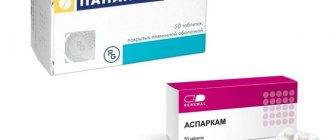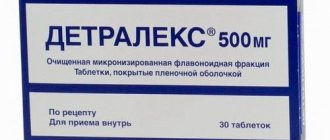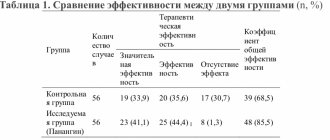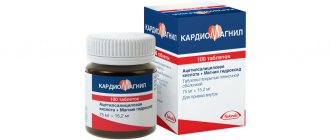Comparing two popular drugs from different groups is a rather difficult task. After all, they may have different indications for use, different areas of use - and in such a situation it is not easy to answer the question of which medicine is better.
This is roughly the situation with the answer to the question: which is better - Panangin or Cardiomagnyl? Although both drugs are used for cardiovascular diseases, they have different pharmacological effects and indications for use. However, many are interested in which of these two medications is preferable to choose for heart ailments, so it is worth understanding this issue in more detail.
Panangin - brief information
Panangin is a combination of potassium and magnesium aspartates . It has an antiarrhythmic effect and is also used to compensate for the deficiency of these elements in the body.
The action of Panangin is due to the fact that it is potassium and magnesium ions that play the main role in ensuring normal contractions of the heart. At the same time, aspartate ions, with which these elements are associated, perform a conductor function, delivering them to myocardial cells.
It should also be noted that a lack of potassium and magnesium in the body leads to the development of metabolic cardiac disorders, atherosclerosis, and arterial hypertension. Taking Panangin thus improves metabolism in the heart muscle, normalizes heart rhythm and blood pressure, and prevents atherosclerotic changes in the coronary vessels.
The drug is widely used in the treatment of ventricular arrhythmias, coronary heart disease, post-infarction conditions, heart failure, and a lack of potassium or magnesium in the body.
Side effects are rare: nausea and dizziness (mainly with intravenous administration), sometimes allergic reactions.
Contraindications for use: renal failure, atrioventricular block, myasthenia gravis, Addison's disease, hyperkalemia, hypermagnesemia, allergy to the components of the drug, acute metabolic disorders.
Application diagram
Panangin is prescribed orally and only after meals. You should not take the drug before meals - the acidic environment in the stomach reduces its effectiveness. The recommended dosage is 1-3 tablets up to three times a day, depending on the initial deficiency of potassium and magnesium. The duration of treatment depends on the severity of the disease.
If the patient cannot take the drug orally, it is prescribed intravenously.
Cardiomagnyl is prescribed only internally. The tablet can be swallowed whole, chewed or broken. Be sure to drink plenty of water. You need to take the drug once a day. The dosage and duration of use depend on the course of the disease.
Cardiomagnyl - brief information
The main active ingredient of cardiomagnyl is acetylsalicylic acid in a dose of 75 mg. In such small dosages, it has almost no analgesic, antipyretic and anti-inflammatory effects, but has a pronounced antiaggregation effect, lowering blood viscosity.
An additional component - magnesium hydroxide - protects the gastric mucosa from the irritating effect of acetylsalicylic acid. Some magnesium is also absorbed into the blood, which should be taken into account when prescribing.
By reducing platelet aggregation, Cardiomagnyl prevents the formation of blood clots, improves the rheological properties of blood (reduces viscosity), helps improve coronary and general circulation, and as a result, the functional state of the heart muscle and the vascular system as a whole.
Used to treat angina pectoris, myocardial infarction, thrombosis, acute and chronic circulatory disorders. In addition, it is widely used for the prevention of thrombotic disorders in persons belonging to risk groups: those suffering from diabetes mellitus, hypertension, obesity, hypercholesterolemia; those who have had heart attacks, strokes, or surgical interventions on the heart and blood vessels; those with a hereditary predisposition to thrombosis, as well as in elderly and senile people.
Contraindicated in case of stomach ulcers, bleeding tendency, or allergies to the components of the drug. Side effects: heartburn, nausea, vomiting, allergic reactions, bronchospasm, hematopoietic disorders, increased risk of bleeding and hemorrhage, stool disorders.
Adverse reactions
Most often, medications cause unwanted symptoms from the digestive tract and cardiovascular system.
Panangin
:
- nausea and vomiting;
- pain in the pancreas;
- atrioventricular block.
With an overdose of potassium, nausea, vomiting, diarrhea, a crawling sensation and other paresthesia develop. Excess magnesium leads to facial flushing, thirst, decreased blood pressure, respiratory depression and seizures.
Cardiomagnyl
:
- heartburn;
- nausea;
- epigastric pain;
- exacerbation of gastric ulcer;
- erosion of the upper intestines;
- bronchospasm;
- increased bleeding;
- headache;
- sleep disorders.
If adverse reactions occur, you should stop treatment and consult a doctor as soon as possible.
What do the two drugs have in common?
Panangin and Cardiomagnyl are pharmacological agents with different properties and characteristics, but both of them are used mainly in cardiology. Their indications for use are also different, but in general, both medications help maintain the health of the heart muscle and normal heart function.
In addition, the scope of application of these drugs does not differ in everything: for example, both of them have a therapeutic effect on coronary heart disease (heart attack, angina).
A common property can be considered the presence of magnesium in the composition, although Panangin contains it as a component of the main substance, and Cardiomagnyl - an additional one. In the body, magnesium is necessary not only for the normal functioning of the heart, but also for the nervous, muscular, vascular, and skeletal systems.
Finally, another similarity can be considered the popularity of these drugs in the treatment of cardiac pathologies, which is primarily due to their quality. Both drugs have various analogues, but they are in less demand.
Differences between Panangin and Cardiomagnyl
The main difference between these two drugs is that they have different pharmacological effects and are therefore prescribed for different pathological conditions.
The main effect of Panangin is antiarrhythmic , while that of Cardiomagnyl is antiplatelet . Panangin normalizes the frequency, rhythm and strength of heart contractions. In contrast, Cardiomagnyl improves the rheological properties of blood and blood circulation in the heart muscle.
There is some difference in the release forms: Cardiomagnil is produced only in tablets, and Panangin is produced in tablets and ampoules (for intravenous injections).
Which of the two drugs is better and why?
Summarizing the information about these popular drugs, you can try to summarize and determine which drug is better - Panangin or Cardiomagnyl?
It is difficult to answer this question unambiguously, but the following conclusions can be drawn:
- Both drugs are important in cardiology, but the importance of Cardiomagnyl is somewhat higher. Still, Panangin - for arrhythmias, heart failure and other conditions - is, albeit important, but not a primary drug (it is used as an addition to cardiac glycosides, antiarrhythmic and other drugs, or as a source of potassium and magnesium). Cardiomagnyl, on the contrary, in most cases is used as a drug of primary importance, and for preventive purposes - often as the only remedy.
- The above is true only in general; as for specific situations, the choice between them depends on the nature of the pathology. For example, for hypokalemia, Panangin should be used, and for a tendency to thrombosis, Cardiomagnyl.
- An important advantage of Panangin is the presence of an injection form of release. This can be significant, for example, for patients with swallowing disorders, or those with mental disorders, for patients in an unconscious state, etc.
- Cardiomagnyl has significantly more side effects, especially with long-term use.
- Finally, it is worth noting that in some heart diseases (myocardial infarction, angina, etc.) there is a need to use both drugs. However, the choice in such a situation should be made by the attending physician.
Medicine and healthComment
Discussion, answers to questions. Kuznetsova I.V.
Vladimir Trofimovich Ivashkin , academician of the Russian Academy of Medical Sciences, Doctor of Medical Sciences:
– Irina Vsevolodovna, hello. Thank you very much for your very interesting lecture. I have a few questions because your lecture evokes so many associations. Please tell me you are talking about patients with dysmenorrhea. Are these patients with long, heavy periods or not necessarily?
Irina Vsevolodovna Kuznetsova , professor, doctor of medical sciences:
- Thank you very much. We have a mixed audience, so I'll just clarify. The term dysmenorrhea is currently interpreted in gynecology as painful menstruation; this is pathological pain that lasts more than 24 hours in the first days of menstruation. It may, of course, be accompanied by more abundant bleeding, but this is not necessary; it is designated by another term - menorrhagia. But dysmenorrhea itself in its pure form is painful menstruation. It can be primary, that is, it arises precisely as a result of a violation of prostaglandin metabolism, usually in young women, or it can be secondary as a result of endometriosis, as a result of inflammatory processes of the pelvic organs, and so on.
Ivashkin V.T.:
- One more question. You mentioned that the combination of magnesium and vitamin B6 could prevent colon cancer. You see, as a gastroenterologist who is actively interested in this problem, I’m hearing this for the first time. And today, of all possible means of prevention, the only thing that has been proven with certainty is that long-term use of aspirin, and then only in patients in whom there is an increase in type 2 oxygenase in detectable polyps, in this case aspirin has such a preventive effect. As for magnesium and vitamin B6, I wonder what points of application, at what stage they can have a preventive effect?
Kuznetsova I.V.:
– By analogy with aspirin, I can assume that this is also cyclooxygenase, since it is associated with the synthesis of prostaglandins, but this is only an assumption.
Ivashkin V.T.:
– Magnesium is not a cyclooxygenase inhibitor.
Kuznetsova I.V.:
– It is not an inhibitor, I completely agree with you. But also, for example, hormonal drugs, while not inhibitors, are nevertheless capable of increasing or decreasing the expression of type 2 cyclooxygenase.
Ivashkin V.T.:
– You see what’s the matter, colon cancer, colorectal cancer is the first most common cancer among gastrointestinal cancers, and its frequency in Russia is very high. To make a recommendation to take magnesium and vitamin B6 for the purpose of cancer prevention, this still requires data from randomized trials.
Kuznetsova I.V.:
– I do not give such recommendations under any circumstances.
Ivashkin V.T.:
– It seems to me that such assumptions among a wide audience about the possibility of vitamin B6 and magnesium somehow influencing the incidence of colorectal cancer are premature, and it may be inappropriate to discuss this issue among a wide audience.
Kuznetsova I.V.:
– I completely agree with you, and, as you noted, I did not give this either in conclusions or in recommendations. She simply indicated that such a consideration had been put forward. Yes, indeed this is a very controversial issue, as controversial as the reduction in the incidence of colorectal cancer with the use of combined oral contraceptives or hormone replacement therapy, although there are randomized and controlled studies, and large epidemiological studies on this. But nevertheless, these studies cannot in any way serve as a basis for offering this remedy as a prevention of this disease, certainly not.
Oksana Mikhailovna Drapkina , professor, doctor of medical sciences:
– Irina Vsevolodovna, they write to us: “Ulan-Ude is also with you.” The question is: what should be the duration of the Magne B6 course and how often should it be repeated?
Kuznetsova I.V.:
– I believe that the optimal duration of the course is a three-month course, at least in our practice of treating patients with premenstrual syndrome with menopausal syndrome, with dysmenorrhea it is usually a three-month course of treatment. And this, of course, is not monotherapy; it is woven into the complex of therapy for these diseases. As for the need to repeat courses - depending on the situation of the disease. That is, in this case, I do not consider the use of magnesium preparations as a preventive measure that would be aimed at preventing one or another gynecological symptoms. These are the drugs that are introduced into the therapy complex if there are corresponding symptoms.
Drapkina O.M.:
– Our viewers are concerned about the question: is it possible to overdose on vitamin B6? That is, we understand that magnesium is not so scary and dangerous, but what about vitamin B6?
Kuznetsova I.V.:
- No. At the doses in which it is prescribed, an overdose of vitamin B6 has not been described, so there is no concern here.
Drapkina O.M.:
– What courses should I take magnesium supplements, how often should I monitor my blood magnesium levels during treatment?
Kuznetsova I.V.:
– There is no need to monitor blood magnesium levels during treatment. And I said the duration of the course above: for me, a three-month course seems optimal. Perhaps neurologists continue this treatment with longer courses, but from a gynecological point of view, a three-month course is adequate.
Drapkina O.M.:
– What are the objective methods for diagnosing magnesium deficiency? And are there specific indications for prescribing magnesium supplements?
Indeed, clinically, not only in a woman, and not only in a woman of reproductive age, but also in a man, can a deficiency be suspected in any person? The only thing that comes to my mind is heart rhythm disturbances.
Kuznetsova I.V.:
– And convulsive symptoms. You understand, of course, these symptoms are very non-specific. Different completely deficiencies give similar symptoms. As a gynecologist, I can speak about premenstrual syndrome and menopausal syndrome as magnesium deficiency conditions. You yourself saw from the slide show, and you know this from clinical practice, that indeed, the symptoms of magnesium deficiency are very similar to the symptoms of estrogen deficiency, and in some cases to the symptoms of calcium deficiency, such as cramps in the calf muscles. That is, sometimes it is very difficult to separate certain nonspecific symptoms from each other, and it is impossible to talk about magnesium deficiency based on symptoms alone. Therefore, I once again return to the fact that it is in our gynecological practice that we talk about diseases that are more associated with magnesium deficiency. I don’t presume to say how to deal with men, you probably know better.
Drapkina O.M.:
– Vladimir Trofimovich, in our therapeutic clinic?..
Ivashkin V.T.:
– It’s generally difficult for me to imagine how to diagnose isolated magnesium deficiency in clinical practice. Firstly, there are no clinical symptoms to suspect magnesium deficiency. Secondly, there is essentially no instrumental data. Let's take, for example, an ion like potassium. These are practically twin brothers: magnesium-potassium are two intracellular elements, both are essential for the functioning of sodium-potassium ATPase. Magnesium is a cofactor for the sodium-potassium ATPase, and all of these symptoms that have been described can essentially indicate potassium deficiency. And all those drugs that were used before, for example Panangin, were a combination of magnesium and potassium. This combination was aimed at activating the sodium-potassium ATPase. Sodium-potassium ATPase is necessary to maintain the transmembrane potential, therefore the convulsive syndrome that is described is characteristic of calcium deficiency, magnesium deficiency, and potassium deficiency, since in all these cases the transmembrane potential changes, and the excitability threshold decreases, and, Accordingly, depolarization processes are disrupted. Therefore, it is very difficult to say that it is magnesium deficiency that underlies all these manifestations. I think that here the combination of magnesium, potassium and calcium cations, a kind of triad, may to some extent explain the varied symptoms that we encounter.
Drapkina O.M.:
– Olga Vladimirovna will add.
Olga Vladimirovna Kotova , associate professor, candidate of medical sciences:
– I am a neurologist and would like to add something about magnesium deficiency. Quite recently, a dissertation on tension headaches was defended at our university. And there, magnesium deficiency was shown and proven in patients with tension headaches. In complex therapy with the use of Magne B6, accordingly, greater results were obtained than in traditional therapy of just tension headaches. And this was proven by the composition, they looked at hair as the most harmless way to study the deficiency.
Drapkina O.M.:
– Yes, it accumulates in the hair.
And they just echo Vladimir Trofimovich’s assumption about Panangin. The viewer also asks a question: wouldn’t it be more correct to prescribe Panangin to compensate for magnesium deficiency? Thanks for the answer.
Kuznetsova I.V.:
– But Panangin is still a complex drug, it contains magnesium and potassium. You understand, there is no “magnesium deficiency” disease, just as there is no “calcium deficiency” disease. There are no such symptoms, so we are saying that there are some diseases that are largely associated with a deficiency of this microelement. As Olga Vladimirovna wonderfully said, thank you for your support - tension headaches are associated with magnesium deficiency. Also, again, I return to the fact that our diseases, menopausal and premenstrual syndrome, are associated precisely with magnesium, and not with potassium deficiency. Therefore, the administration of potassium - studies were conducted - did not lead to positive changes. And the administration of the drug Magne B6 really gave a good positive effect. Of course, there are probably some nuances in the symptoms, because after all, when such an emotional and mental spectrum of disorders predominates in our patients, plus convulsive, spasmophilic disorders, then we can suspect magnesium deficiency to a greater extent. If there is a tendency, say, to swelling, then we may encounter a deficiency of other microelements.
As for calcium, when we talk about premenopause and postmenopause, there are simply no questions - this is always a calcium-deficient age, and therefore we also add calcium supplements there. And, of course, I completely agree with Vladimir Trofimovich, because of course not only the replenishment of magnesium and vitamin B6, but also other drugs, other microelements, other vitamins are also needed in order to maintain health and solve the problems that come with us a patient.
Drapkina O.M.:
– The question is this: almost all pregnant women are prescribed magnesium. Does it have hepatotoxicity?
Kuznetsova I.V.:
– This question is probably not for me. But I’ll probably say a few words about the fact that indeed all pregnant women are prescribed magnesium supplements. Maybe not for everyone, but it is prescribed very often, probably more often than it should. Polypharmacy during pregnancy is, of course, scary. Absolutely not all pregnant women need magnesium and vitamin B supplements. Moreover, there are vitamins that are much more important for pregnancy, for example, folic acid, which is absolutely necessary for the development of the child and the prevention of some complications associated with hyperhomocysteinemia. But as for Magne B6, its use during pregnancy should, of course, be limited to certain indications, but this has not yet been done. I think that I cannot judge him regarding hepatotoxicity; I have not seen hepatotoxic effects during pregnancy in patients taking magnesium supplements.
Drapkina O.M.:
– From Vladikavkaz, a question: can children with hyperactivity take Magne B6? It's probably good when a child is hyperactive?
Kuznetsova I.V.:
– No, this is not good, but this is not a question for me, this is for neurologists. Thanks a lot.
Kotova O.V.:
– Sorry for interfering, but magnesium for hyperactivity in children is perhaps the safest drug on the entire list that we can offer, from antidepressants to antipsychotics, so we start with more neutral drugs.
Drapkina O.M.:
– What does hyperactivity mean?
Kotova O.V.:
– Attention deficit disorder, ADHD, in short. Excuse me, I am interfering with my neurological topic, or rather, it is semi-psychiatric, because ADHD very often turns into autism, and then not even neurological, but psychiatric problems.
Drapkina O.M.:
- Thanks a lot. Vladimir Trofimovich?
Ivashkin V.T.:
– I think this is a very interesting point of view on the role of magnesium, of course, we should support. I think that it is still necessary to narrow the niche for the use of magnesium, since the extreme expansion of this niche devalues the real significance of this drug. Otherwise, it turns out that you don’t need to control it: you don’t need to control the dosage, you don’t need to control the concentration, and so on - it essentially turns into mineral water, which you can drink in unlimited quantities, without controlling the flow of ions, and so on. Therefore, it seems to me that there should still be a fairly clearly defined niche for those nosological conditions or those syndromes for which this combination of vitamin B6 and magnesium should be used.
Then it’s not entirely clear why exactly this combination? Vitamin B6 is important for protein metabolism, magnesium is a cofactor in maybe a hundred or more different intracellular reactions. Why this combination? In the next lecture, it might be advisable to tell you about this.
Next, of course, it is very important to tell the transport system of magnesium ions: how the magnesium ion enters the cell, the systems for regulating the entry of magnesium into the cell and the exit of magnesium from the cell; is it an active process or a passive one; and how magnesium transport can be controlled at the level of the cell membrane. Here are these three questions: why the combination of vitamin B6 and magnesium, then the transport processes of magnesium, and yet a clearer limitation of nosological conditions and syndromes in which the effect of magnesium was actually obtained using randomized or sequential observations, of course, this would greatly enhance position of this drug.
Drapkina O.M.:
– Thank you very much, Irina Vsevolodovna, for the lecture and for the numerous questions that you had to answer. Thank you and see you next time.
Kuznetsova I.V.:
– Thank you very much, see you later.









